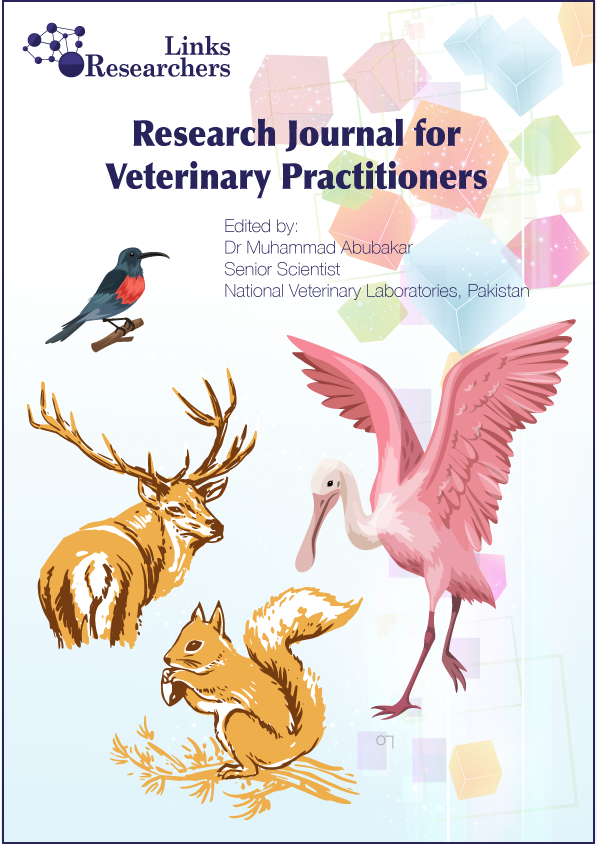Research Journal for Veterinary Practitioners
Case Report
Research Journal for Veterinary Practitioners 1 (4): 46Coccidiosis in Buffalo Calf; a Case Report
Mohammad Iqbal Yatoo*, Deepa Padinjare Melepad, Umesh Dimri
-
Division of Medicine, Indian Veterinary Research Institute, Izatnagar 243 122, Bareilly, U.P. (India)
*Corresponding author:iqbalyatoo@gmail.com
ARTICLE CITATION:
Yatoo MI, Melepad DP and Dimri U (2013). Coccidiosis in buffalo calf; a case report. Res. J. Vet. Pract. 1 (4): 46
Received: 2013–10–04, Revised: 2013–11–10, Accepted: 2013–11–14
The electronic version of this article is the complete one and can be found online at
(
http://nexusacademicpublishers.com/table_contents_detail/13/138/html
)
which permits unrestricted use, distribution, and reproduction in any medium, provided the original work is properly cited
ABSTRACT
A 20 day old female buffalo calf suffering from severe diarrhea due to coccidiosis was treated with Sulphadiazine and Trimethoprim along with fluid, electrolyte and multivitamin preparations. Animal showed marked improvement after 3 days post–treatment.
Coccidiosis causes severe economic losses due to reduction of feed efficiency, slower weight gain and increases susceptibility to other diseases (Thomas, 1994). It occurs mainly in young animals because of lower immune competence. In buffalo calves, coccidiosis causes severe diarrhea, dysentery, dehydration, depression, anorexia, weakness and recumbency (Ahmed and Hassan Soad, 2007). Sometimes nervous signs are also found in coccidiosis (Teankum et al. 2003). It is usually caused by sporozoan protozoa Eimeria spp. In winter mostly E. zuerni is involved in infection but Eimeria bovis is also common (Geurden et al. 2005).
A 20 day old female buffalo calf was presented at Referral Veterinary Poly clinic at IVRI with the complaint of diarrhea, anorexia, weakness and depression. Animal was having diarrhoea from last a few days. Blood stains were also observed near anal region.
On clinical examination heart rate was 54/minute, respiration rate 28/minute and rectal temperature 103.2oF. Mucous membrane was pale and anaemic. Animal was dehydrated and recumbent. Faecal sample was taken for examination to check the presence of parasites or their eggs. On faecal examination, typical oocysts/sporocyst of Eimeria spp. were found under microscope having four sporocysts, each containing two sporozoites. Other parasites or their eggs were not noticed in faecal sample. So on the basis of clinical symptoms and results of faecal examination it was confirmed that animal was suffering with coccidiosis.
Sulphadiazine and Trimethoprim (Biotrim I.V injection@ 4 ml intravenously) were given for three days to control infection. Meloxicam (Melonex plus injection@ 2ml intravenously) was also administered for three days to prevent fever and inflammation. Dextrose normal saline (DNS@250 ml) and Ringer's lactate (RL@200 ml) was given intravenously along with multivitamin preparation (Conciplex@ 3ml) to prevent dehydration and electrolyte imbalance. Animal showed marked improvement 3 days post–treatment.
Coccidiosis affects young calves as they are as they are immuno–compromised, highly moist surroundings and presence of oocysts in maternal faeces. In India, prevalence of coccidiosis among buffaloes in Patna (Bihar state) was reported to be 25% (Priti et al. 2008). Eimeria spp. is frequently involved (Antonio et al. 2009). It causes severe enteritis resulting in diarrhea, dysentery and dehydration. Enhancing immunity of calves by proper colostrum feeding and prevention of infection from contaminated feed or fodder are the important steps for controlling coccidiosis in early life.
REFERENCES
Ahmed WM and Soad EH (2007). Applied studies on coccidiosis in growing buffalo–calves with special reference to oxidant/antioxidant status. World J. Zoology 2 (2): 40–48.
Geurden T Claerebout E and Vercruysse J (2005). Protozoan infection causes diarrhea in calves. Tijdschr Diergeneeskd. 130: 734–737.
PMid:16363207
Noronha ACF Jr Starke–Buzetti WA and Duszynski DW (2009). Eimeria Spp. in Brazilian water buffalo. J. Parasitol. 95(1): 231–234.
http://dx.doi.org/10.1645/GE-1605.1
PMid:18662041
Priti M Sinha SRP Sucheta S Verma SB Sharma SK Mandal KG (2008). Prevalence of bovine coccidiosis at Patna. J Vet. Parasit. 22(2): 73–76.
Teankum K Pirarat N and Moungyai M (2003). Eimeria zuernii infection in Thai native calves. Thai J. Vet. Med. 33 (2): 114–118.
Thomas HS (1994). Coccidiosis in calves. The Cattleman. 81: 21–32.






